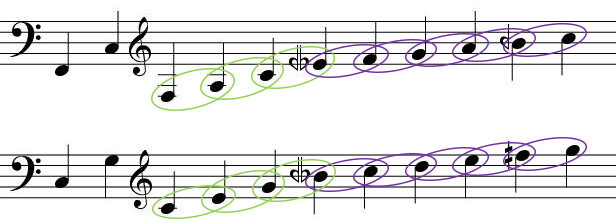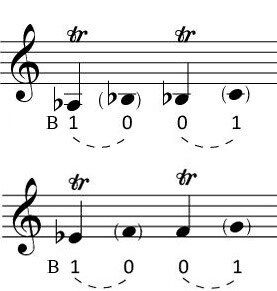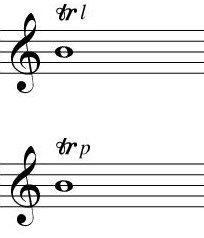- Home
- »
- Trills
Trills
Lip trill
Valve trill
Chaotic trill
On the horn, trills are traditionally played with the lips, by rapidly alternating between two successive harmonics.
This means that, since there are almost no semitones within the playable range of the harmonic series, this technique can only produce trills that span a whole tone up or down (as shown in purple in the example).
One can also play trills on a minor or major third (as shown in green in the example); when played quickly, these will sound similar to whole tone trills. This is in fact the technique often used by trombonists, since their range rarely allows for harmonics close enough to produce a true whole-tone lip trill.
It also means that lip trills in the medium-low register are impossible, since the harmonics in that range are spaced more than a tone or a third apart.

On the horn, trills are traditionally played with the lips, by rapidly alternating between two successive harmonics.
This means that, since there are almost no semitones within the playable range of the harmonic series, this technique can only produce trills that span a whole tone up or down (as shown in purple in the example).

One can also play trills on a minor or major third (as shown in green in the example); when played quickly, these will sound similar to whole tone trills. This is in fact the technique often used by trombonists, since their range rarely allows for harmonics close enough to produce a true whole-tone lip trill.
It also means that lip trills in the medium-low register are impossible, since the harmonics in that range are spaced more than a tone or a third apart.
In this excerpt from Weber’s Concertino for Horn, the black notes represent what is written in the horn part (originally in E, here transposed to F for clarity), the orange notes show what Weber likely intended to be heard in relation to the harmony of the passage, and the blue notes indicate the actual pitches that are produced when performing this passage using lip trills (since valves had not yet been invented in Weber’s time).

Weber – Concertino for Horn in E Major – bar 319
Note: The small notes in parentheses are added here for pedagogical purposes; they are normally implied and not written in the score.
To compensate for the inability to perform a semitone trill with the lips, it can be done with the valves. There is usually always a fingering for it, although it can sometimes be tricky due to the risk of shifting to the lower harmonic instead of the upper harmonic.
For the 2nd trill (b♭/c in C) shown here, since a♭ and c are played with the same fingering, there is a risk of moving from b♭ to a♭ instead of from b♭ to c.

One can of course play hole tone valve trills, but they will sound less smooth than when done with the lips.
Lip trill
Valve trill

Lip trill
Valve trill

Valve trills also allow trilling in all registers, whereas they can only be played from the medium-high register with the lips, as the harmonics are more spaced out in the lower registers.
By instinct, a horn player will always trill in the way that suits them, typically favoring the traditional lip trill. To ensure that they perform all the trills the same way, it’s best to specify this in the notice (provided all the trills in the score are written in a way that makes them feasible with the chosen technique, especially those requiring lip trills). If, on the other hand, the player must perform some trills with the lips and others with the valves, it’s important to choose a notation that clearly differentiates them. A simple example could be “l tr” for a lip trill and “v tr” for a valve trill.

